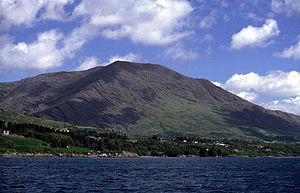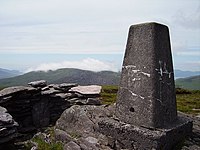Hungry Hill
| Hungry Hill | |||
| County Cork | |||
|---|---|---|---|
 Hungry Hill | |||
| Range: | Caha Mountains | ||
| Summit: | 2,247 feet V761497 51°41’9"N, 9°47’31"W | ||
Hungry Hill is a mountain on the Beara Peninsula, in County Cork. It is amongst the Caha Mountains.
Name
The first part of the Irish name Cnoc Daod means "hill". The second part may be a dialectal variant of déad, meaning "tooth", "set of teeth" or "jaw". It has been anglicized as Knockdhead and Knockday.[1]
Geography

With a height of 2,247 feet, Hungry Hill it is the highest peak of the Caha Mountains. It stands on the border of counties Cork and Kerry, the peak being on the Cork side.
There is a cairn at the summit and a number of standing stones to the south and east of the mountain. At its eastern foot are two lakes — Coomadayallig and Coomarkane — which both drain into the Mare's Tail waterfall, which is the highest waterfall in the British Isles.
In popular culture
Hungry Hill is the title and setting of a 1943 novel by English author Daphne du Maurier. Her descriptions of the mountain and environs are markedly similar to the actual location. In the novel, the name of the mountain is metaphoric, as during the course of the novel the mountain seems to ‘swallow’ successive generations of the Broderick family, who own and mine the mountain. The story is reputedly based on the Irish ancestors of Daphne du Maurier’s friend Christopher Puxley.
| ("Wikimedia Commons" has material about Hungry Hill) |
